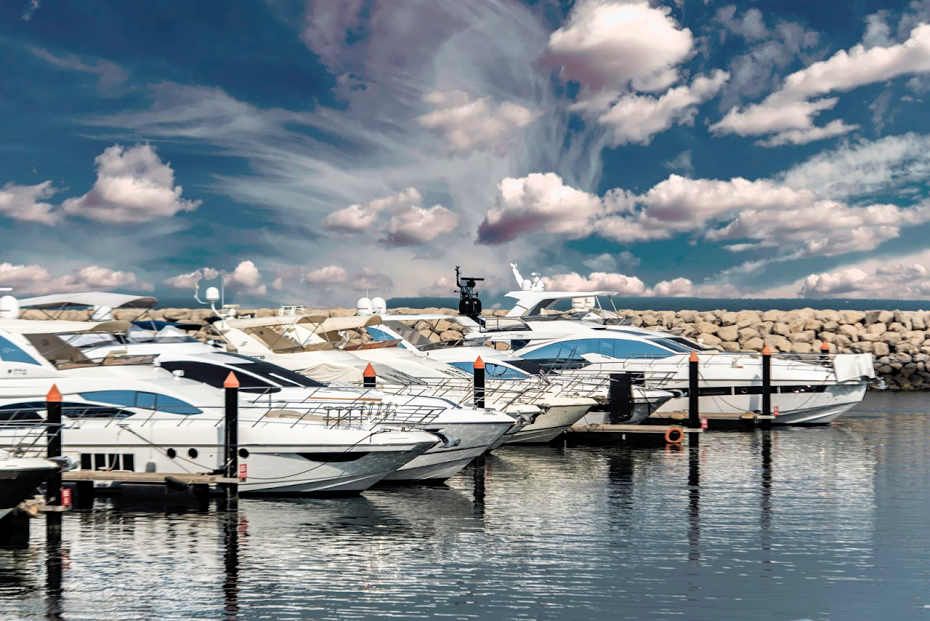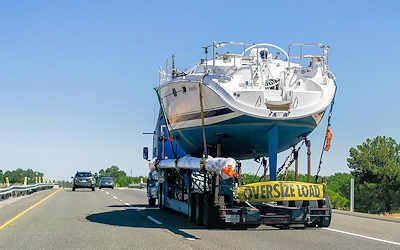The Marine Web Blog
The Marine Web Blog

By Steve Rogers
•
23 Feb, 2023
Marina life refers to the lifestyle and activities associated with marinas, which are docking facilities for boats and yachts. Marinas are usually located along the waterfront, providing access to various water-related activities such as boating, fishing, and water sports. Marina life offers a unique and exciting experience for people who love the water and the outdoors. Marinas are essential for waterfront communities as they provide a range of economic and social benefits. Marinas attract tourists and boaters, which creates new revenue streams and employment opportunities for local businesses. Additionally, marinas provide a safe and secure location for boats, reducing the risk of environmental damage and promoting sustainability in local waterways. Marinas also create a sense of community among boaters and other visitors, providing opportunities for socialization, education, and cultural exchange. The best parts of marina life are docking, dining, and discovering. Docking, dining, and discovering are the most exciting and rewarding aspects of marina life . Docking provides a safe and secure location for boats, while dining offers a unique waterfront experience and contributes to local economies. Discovering offers a range of activities for boaters and visitors, promoting tourism and creating a sense of community among boaters. Together, these three aspects of marina life offer a complete and fulfilling experience for anyone who loves the water and the outdoors. Docking Docking is an essential aspect of marina life. It refers to the process of bringing a boat into a marina and securing it to a dock. Docking in a marina provides several benefits to boaters. For instance, it offers a safe and secure place to moor a boat, which protects it from harsh weather conditions such as strong winds and waves. Additionally, marinas have staff on hand to assist with docking, which can be particularly helpful for novice boaters. Different types of boats can dock in marinas, ranging from small personal watercraft to large yachts. Docking in a marina also offers several advantages over using a private dock. Firstly, marinas are equipped with various amenities such as showers, laundry facilities, and electrical hookups, which are not usually available on private docks. Secondly, marinas offer access to a wider range of services such as fueling stations, pump-out stations, and boat repairs. Finally, marinas often provide a community of fellow boaters, which creates a social and supportive atmosphere for people who share a love for the water. Dining Marina life is not only about boating but also about dining. Marinas typically have restaurants, cafes, and bars that cater to boaters and other visitors. Dining in marinas is an excellent way to enjoy waterfront views while sampling local cuisines. Restaurants in marinas offer a wide range of menus, from seafood to fine dining, to casual family-friendly options. Many marina restaurants have outdoor seating, which provides a beautiful ambiance and a great spot to watch boats go by. Dining in marinas also plays an important role in local economies. Marinas attract tourists who are interested in boating and waterfront activities. They offer a unique dining experience that is different from typical restaurants, and this brings new customers and revenue to local communities. Marina restaurants also provide job opportunities for local residents, contributing to the overall growth of the local economy. Discovering Discovering is an essential aspect of marina life, which refers to the many activities available in and around marinas. Marina life offers a wide range of activities, such as water sports, fishing, hiking, biking, and shopping. Boaters can take advantage of the marina's location to explore nearby attractions such as beaches, museums, and other cultural sites. Marinas also play an important role in promoting tourism in local areas. They offer unique experiences for visitors who are interested in boating and waterfront activities. Marinas also provide opportunities for local businesses such as hotels, shops, and tour operators to promote their services to boaters and other visitors. Furthermore, marinas offer an excellent community for people who share a love for the water. Boaters can meet and socialize with other boaters, exchanging experiences, and learning from each other. Marinas often organize social events and activities, such as fishing tournaments and regattas, which create a sense of camaraderie among the boating community. Conclusion Docking, dining, and discovering are the best parts of marina life. Docking provides a safe and secure place for boats to moor and access to essential amenities, while dining offers a unique waterfront experience and contributes to local economies. Discovering provides a range of activities for boaters and visitors, promoting tourism and creating a sense of community among boaters. Marinas play a significant role in waterfront communities, offering unique experiences for people who love the water and contributing to local economies. Whether you are a seasoned boater or a first-time visitor, marina life has something to offer for everyone.

By Jason Mueller
•
15 Jul, 2022
Whether you’ve purchased a boat in another state, are moving house, or transporting the vessel cross-country, the process can seem daunting. The first thing you need to do is decide whether you want road or sea transport. Usually, this choice is based on convenience, price, the boat’s size, etc. But this isn’t the only decision you’ll need to make. Here, we’ll review the most popular ways to transport a boat cross-country, discuss the price, and offer tips to make the process easier. The Most Popular Ways to Transport a Boat Cross-Country There are several ways to transport your boat cross-country. Which one you choose depends on many factors. 1. Shipping a Boat Cross-Country Over Land The most popular method for shipping a boat cross-country is over land. Here, you have several options to choose from. The first option is shipping the boat on its trailer. If you’ve purchased a boat-motor-trailer package, you may be able to transport the boat on your own, without hiring a professional. While this method is cost-effective, transporting a boat by yourself can be risky, especially if you haven’t done it before. First of all, you need to have a vehicle that can handle hauling the load. If you don’t, you can always rent a truck, but this leads to a higher total cost. Plus, transporting a boat on your own can be time-consuming. Many boat owners are uncomfortable with hauling the boat by themselves and decide to hire a professional. Professionals can load boats on flatbeds or step-deck trailers and transport them from one location to another. To be hauled over land, your boat needs to fulfill certain requirements: It can’t be wider than 12 feet The total height can’t exceed 13 feet, 6 inches The total gross weight can’t be more than 80,000 pounds If your boat meets all the requirements, you can hire a professional to deliver it with a flatbed or multi-boat trailer. There’s another option if your boat is larger: transportation via truck. Because of the ship’s size, this method would be more expensive. You’ll need to pay for overweight or oversize permits and possibly escort vehicles. 2. Shipping a Boat Cross-Country by Ship A yacht transport ship may be the best option for shipping large or high-end boats. This is a significantly more expensive option and involves a lot of paperwork. If you opt for this shipping method, be careful about the company you hire. The company should be experienced, reputable, and professional. If you have a smaller boat, you can ship it inside an enclosed container or roll-on roll-off (RORO). The container option is great because it allows you to send other belongings besides the boat. The downside is that securing the boat inside the container can be tricky. Boats often shift during transit and get damaged in the process. If you go for the RORO option, you’ll need to drive your boat to the agreed location, secure it, and pick it up at its final destination. This method is secure, and there’s less risk of damage, but it’s also more expensive. 3. Drive the Boat Yourself Many boat owners decide to make an adventure out of transporting their boat cross-country. While this is a good option for short-distance trips, it can be challenging and time-consuming if you need to travel large distances. There’s always the option of hiring a professional captain to transport your boat from point A to point B. Keep in mind that this can be expensive as you’ll need to pay for the fuel, insurance , and flying the captain home. Plus, you’ll need to be prepared for potential additional costs due to mechanical issues, severe weather conditions, etc. How Much Does It Cost to Ship a Boat Cross-Country? There’s no universal formula for calculating the cost of shipping a boat cross-country. The final cost depends on your boat’s size, the desired transportation method, the total distance, the season, etc. If you want to get an estimate, you’ll need to provide the pickup and drop-off locations and exact boat measurements. Here are the measurements you’ll need: Boat length – This is measured from the tip of the bow to the middle of the stern. Since boat lengths can limit your options in terms of transportation methods, this measurement is vital. Boat height – This is measured from the keel (the boat’s lowest part) to the boat’s highest part. Before measuring the height, take off any removable parts. Boat width – This is the distance between the boat’s widest part. Here are a few examples of estimated costs for shipping an 11-foot boat according to the A-1 Auto Transport website : Shipping a boat from Los Angeles to Las Vegas costs around $740 and takes roughly 2-4 days. Shipping a boat from Seattle to Phoenix costs around $3,920 and takes approximately 4-6 days. Shipping a boat from Miami to Denver costs around $5,680 and takes roughly 6-8 days. How to Prepare for the Boat Shipping Process If you decide to hire a professional to transport your boat, you’ll need to prepare your boat before turning it over to the company. First of all, you’ll need to ensure there’s no fuel in the tank. Then, you’ll need to disconnect all electrical components, including alarms. Since any loose items can get damaged during transportation, removing them is best. This includes electronics, antennas, valuables, anchors, etc. Most boat transportation companies won’t be responsible for any damage caused by loose items in your boat. Lastly, you’ll need to secure the doors, windows, and hatches inside the boat. Keep in mind that the preparation process depends on the company you hire. If you’re not sure what to do, ask the employees to explain. How to Choose a Boat Transportation Company If you want to have peace of mind knowing your boat will reach the destination safely, hiring a professional boat transportation company is the best choice. However, finding the right company can be difficult. The first thing you should look for is experience. You want to hire a reputable company that has completed hundreds of successful jobs and has many satisfied customers. Do your research online, read the reviews, and you’ll be able to determine whether a company is the right fit for you. In addition, it’s essential to ensure the company does its business in line with the DOT regulations. You don’t want to encounter problems along the way because of missing paperwork, licenses, or insurance. Ask to see the company’s paperwork before hiring them. Lastly, pay attention to how the employees treat you. They should be professional and ready to answer all your questions. If they are rude or unprofessional, the company may not be the best choice. Transport Your Boat Safely Although it may be tempting to transport the boat yourself to reduce costs, this isn’t the best idea, especially over long distances. Hiring professionals may be a more expensive option, but it has numerous benefits. They have the equipment, knowledge, and experience to transport your boat safely and quickly. Most importantly, you can be 100% sure your boat is in safe hands.

By Roger Kostman
•
01 Feb, 2021
Starting your own business is rewarding for many reasons. You get to set your own schedule, be your own boss, and create the perfect work environment. This can be a great fit for parents living with disabilities because you also have more time with your family and the opportunity to make a living without having to deal with workplace discrimination. If you’re living with a disability, chances are you’re no stranger to juggling responsibilities and overcoming obstacles. These qualities are vital in getting a small business up and running. If you’re wondering how to get started, the following tips will point you in the right direction. Consider a home-based business. Many traditional workplaces fail to meet accessibility standards , and too many employers are reluctant to make the necessary accommodations for employees with disabilities. While this is gradually changing, it’s still frustrating and discouraging to feel excluded from the workforce. One way to avoid accessibility and mobility hurdles entirely is to start a home-based business. You’ll be able to create your own accessible workplace, and you’ll have more time to devote to your family and fledgling business. Your next step will be to decide what type of home-based business is right for you. Although most people picture IT or other computer-based jobs when they think about working from home, a home-based business isn’t limited to the technology sector. There are many other possibilities , such as reselling, pet boarding, beauty services, selling handmade goods, online tutoring, consulting, and so many more. Connect and plan. Once you have a business idea, it’s time to make a plan. Although you likely have plenty of self-starting energy and resilience, there is no need to go through this stage alone. Consider reaching out and using entrepreneurship resources that are designed to help small business owners. For example, you can access webinars, online business mentoring sessions, or connect with other small business owners through your local chamber of commerce. This kind of social support offers both learning opportunities and an important sense of belonging. Your business plan should articulate everything about your business, from how it will function to how you’ll access your target market. A business plan is also important for gaining investment, funding, and loans. At this stage, you’ll need to decide how to structure your business . A limited liability company (LLC) is a great option for parents with disabilities because it involves less paperwork, offers more flexibility, and has tax advantages. You can save money by filing yourself or using a formation service . Get special funding. Once you’re armed with your business plan, you’re ready to explore the many special funding opportunities available to disabled business owners. In addition to federal funding , there are grants available to qualifying disabled people from various foundations, non-profits , and private organizations. You can access these by searching online databases or contacting your local Small Business Development Center for support. Even if it takes a bit of digging to find funding, try not to get discouraged. There are people who specialize in helping people with disabilities get the financial funding they need. While starting a small business can be a great fit for disabled parents, it pays to be prepared for some challenges. Fortunately, small business ownership is more accessible than ever before, and a disability doesn’t have to come between you and a productive professional life. To get started on your business ownership journey, make sure you choose the right set-up, connect with others for support, take advantage of special funding, and embrace the entrepreneurial spirit. This is the kind of insightful and inspiring content you can find on The Marine Web blog .

© 2024
All Rights Reserved | The Marine Web
Where boaters can find boats for sale, new boat trailers, marine services, boats for charter and much more. Bookmark us now!
Marine Industry Professionals, see our
Contact us about advertising on this page.




